waynorth
Dealer / Materials Provider
- Joined
- Nov 19, 2005
- Messages
- 30,182
Can you name that catalogue for me, please??Coffee pruners from the 1894 catalogue.
Can you name that catalogue for me, please??Coffee pruners from the 1894 catalogue.
Interestingly, my tobacco Pruner came from someone in Port Stanley, Ontario, which area became Canada's "Tobacco belt" when the "Empire Loyalists" moved their tobacco interests from the southern parts of America after the revolution of independence from Britain!! The growing conditions were right for tobacco!!What a great find Ed!!! I've got a similar one myself!!View attachment 2559217
I was aware of yours from having seen it yrs back, it being more desirable again as a folder. Can you kindly post a pic of it closed?What a great find Ed!!! I've got a similar one myself!!View attachment 2559217
I was aware of yours from having seen it yrs back, it being more desirable again as a folder. Can you kindly post a pic of it closed?
Took me some time to find who it was who posted that but I did remember it was described as a tobacco knife iirc which helped me find yours.
Like yourself I thought mine was of an earlier era.
The catalogue pic was from the "Rogers 1894 Catalogue" as supplied by Bernard Levine.
To answerWill Power , Bernard was pretty certain that despite the obvious aged aesthetic it was "self consciously old fashioned".
So what I understand from this that is perhaps Rogers were doing a retrospective look back at their golden days? Like a spyderco sprint run of an early heritage line if you get me?
Also the manner in which the typesetting of the block making for the text was done in a more modern format, by machine.
He mentioned scratted bone was also in use up to WW1 on certain utility lines.
Personally I'd have bet the farm it wasnt GV but unless somone knows better I've no reason to doubt him, he's forgotten more than I know about this.
One final addendum, he questioned if it was actually shear steel.
I have several examples of real shear steel and all have a under close inspection a stacked almost laminate appearance. My Gregory Bros and Petty knives have this. The above does have this too so I'm satisfied it is shear. I'd know for certain by the edge it takes and holds but am slow to press this one into use.
Thanks a mill for the link, shear, double and even triple shear steel is one of my areas of special interest
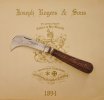
Your dates are the same ones Bernie Levine used to somewhat prove that "scratting" at least dated to 1911-1912 before it disappeared from catalogs, and manufacturers offerings!!The name is "Joseph Rodgers" not "Rogers". With that said, those Rodgers pruner models, both fixed and folding, are seen in "real" Joseph Rodgers catalogs from 1865 through c. 1912.
It appears I'm guilty of the misspelling myself, apologies, the majority of my posts are done with a little one on my knee and spell correct defaults the spelling. That and I'm a bit thickWith all due respect to Bernard Levine, the information given by him was from a very poor undocumented copy of "some" catalog. The front cover does not even spell the company's name correctly.
The name is "Joseph Rodgers" not "Rogers". With that said, those Rodgers pruner models, both fixed and folding, are seen in "real" Joseph Rodgers catalogs from 1865 through c. 1912.
Enclosed is a folding example sitting on the sub-par 1894 photo copy catalog with no proof of date.
View attachment 2559451
I assume its flush and square joint Waynorth? If it is it's a slam dunkHere you are, Ed!!!View attachment 2559430View attachment 2559431
4 3/4" long, and the Rattail bolster is small, but not intergral!!
Absolute showstopper Waynorth. Flush and square presents such a challenge to a maker and it's a joy to see executed as cleanly as that. As we say round these parts well wear!Here's my old pic of the joint - yes, it's flush and square!!View attachment 2559707
I have read on this site regards scratting and it's dating, a bit of a hot potatoThe Coffee Pruner and Scratting Saga is becoming really intriguing.
H herder Makes a very valuable point, and displays a fantastic knife with amazing finish and a very appealing bolster. Not sure what it's called but it's like a pinched Rat-Tail if you get the meaning, small detailed bolsters always look at home on these type of knives aesthetically.
Of course, B.Levine is rightly an immense authority and in some ways his work on cataloguing can be likened to Dr.Johnson in England whose epic was to produce a Dictionary of The English Language in the c18th. A massive and daunting task, tackled only by giants, so too with Bernard Levine. However, while 'No Man is an Island' nor is anybody infallible as we all know. Find it really difficult to accept that Scratting went on for such a long time after jigging and Cell had been established. Of course, a quantity of Scratted slabs may have been left laying around in a workshop for decades and somebody decided to use them up. But in Victorian, early C20th times people were less nostalgic about old styles or materials as we have become as c21st collectors, and might well have looked at these things as quaint or even ridiculously old fashioned and just thrown them out- Think clothing styles or even architecture, the Victorians spent a lot of time and money destroying Georgian buildings and older, replacing then with their Neo Gothic taste. My belief is thatwaynorth Charlie's folding Pruner is Victorian, Levine was an authority but may have been giving an opinion based unwittingly on faulty info?
Would like to see some more close-ups of the blade stamp on the Coffee Pruner, think there may be a difference between small tang stamps/markings cut by hand and larger stamps that might have been machined, might. Remember that the early c19th was a time of very rapid change as industrialisation swept England and other countries: innovations in machinery, advent of the first railway, printing, engraving, steel nibs for pens etc all took place in the first 30 years of the century .
Without seeing the knives in question in the hand you can never be sure, but this much I'd be certain, these knives are most certainly in the Golden Age era and the discussion, when on knives, is as rewarding as ever.
Thanks, Will



I would guess it's inter war period but that's a guess. The blade stamping looks later that Edwardian imo. Love the tang and the contrasting heart wood on the obverse, kind of reminds me of lignum vitae wood. A lovely pocket knife PT.Can anyone tell me if this Joseph Rodgers knife is within these dates?
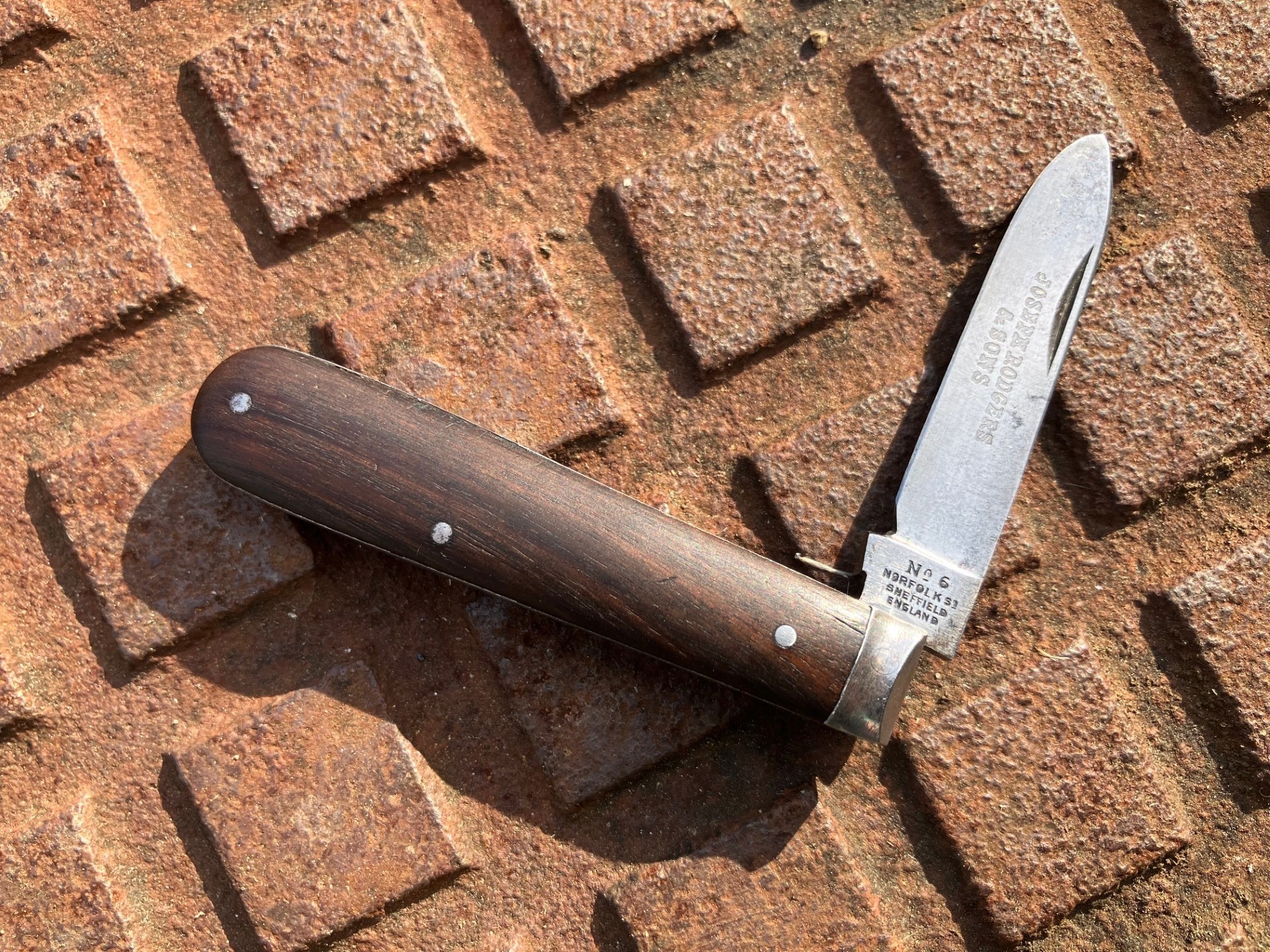

If it helps, here are the tang stampings; how to tell if they are machine cut, I don't know!!how the stamps were cut, and that they displayed signs of being pantograph reduced from larger images, i.e. machine made. By contrast, in the time of George IV and before, stamping dies were cut freehand at actual size
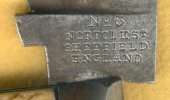
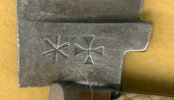
Scratting from 2015!!!!I have read on this site regards scratting and it's dating, a bit of a hot potato
Bernard suggests that generally scratted bone is early but on some stout traditional tool or farm knives it continued in use, even into the 1930s. I have nothing to contribute here as my knowledge on a scratting is minimal...
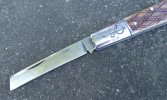
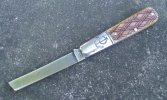
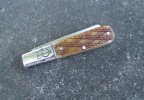
Hey hey! Fantastic, is that your handy work?Scratting from 2015!!!!View attachment 2559759View attachment 2559760View attachment 2559762
Ha Ha!! Of course intentionally done as a tribute to the old "Art" of scratting!!
Back to Sheffield!!!!. . . . . . . . . . . .

That's a limited production SFO from GEC!!!Hey hey! Fantastic, is that work handy work?
Here's a very early example of scratting I have shown before,
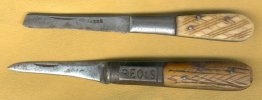
Sorry I have to post the reply and edit the pics I after or the page refreshes and I lose the post, most annoying and I'm not smart enough with tech to figure a workaround.That's a limited production SFO from GEC!!!
Can't see your picture, Ed??!!
Here are two old Scratted Barlows!!
Three opinions are that the top one in near 200 years old!!
It, with its blade, inspired the GEC production!!
View attachment 2559804



I'm not sure which it Oates is, Ed!! Jack Black can likely tell us when he gets back from Greece!!!Oates Barlow maker from Sheffield
